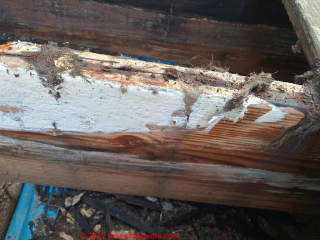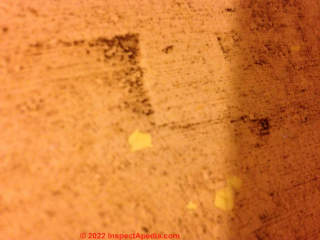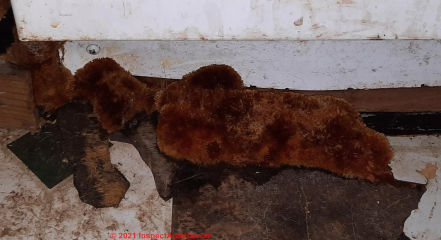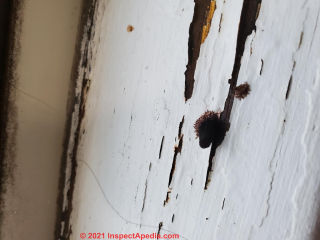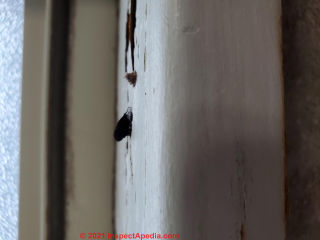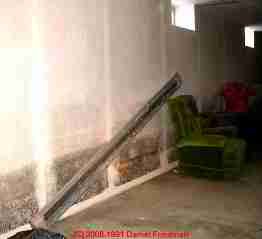 Indoor Mold Contamination FAQs
Indoor Mold Contamination FAQs
Questions & answers about building mold contamination
- POST a QUESTION or COMMENT about how to find, test for, remove, clean up and prevent mold contamination in buildings
Frequently-asked Quest ins & Answers about indoor mold contamination:
Questions about What to Do About Black Mold and other Indoor Air Quality IAQ Contaminants.
Questions about How to test, remove, or prevent mold contamination. And questions on How to deal with mold related illness.
This website answers just about any thing you want to know about what to do about mold contamination in buildings: how to find, test, remove, clean-up or prevent indoor mold contamination. These mold-action & indoor environment investigation & cleanup articles provide expert, un-biased information for owners, occupants, inspectors.
How to recognize mold, how to test for unsafe mold, how to clean up or remove mold, how to prevent mold contamination in buildings, and what mold related illnesses and symptoms have been reported are all discussed in depth.
InspectAPedia tolerates no conflicts of interest. We have no relationship with advertisers, products, or services discussed at this website.
How to Find, Test, Inspect For, Remove, & Prevent Indoor Mold Contamination: what to do about mold in buildings
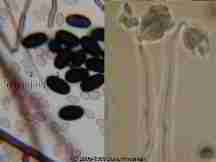 In this article series we give detailed and authoritative information and procedures for finding, testing, cleaning and preventing indoor mold, toxic black mold, green mold, testing building indoor air quality, and other sick house / sick building investigations.
In this article series we give detailed and authoritative information and procedures for finding, testing, cleaning and preventing indoor mold, toxic black mold, green mold, testing building indoor air quality, and other sick house / sick building investigations.
[Click to enlarge any image]
To find what you need quickly, if you don't want to scroll through this index you are welcome to use the page top or bottom SEARCH BOX to search InspectApedia for specific articles and information.
These questions & answers were posted originally at MOLD CONTAMINATION IN BUILDINGS - topic home.
Basic Advice for Mold Contaminated Buildings
Small areas of mold, if that's all you've got, say less than 30 sqft of contiguous moldy material, are usually handled as a normal cleanup job without heroic efforts, For a small or DIY mold cleanup project see
- MOLD CLEANUP, DO IT YOURSELF
- MOLD CLEANUP - SAFETY WARNINGS.
- MOLD CLEANERS - WHAT TO USE
- MOLD CLEANUP with BLEACH
- MOLD CLEANUP - MISTAKES to AVOID
Larger areas of mold contamination, or if a larger area is discovered in cleaning the small one, do indeed merit professional cleaning. When a professional mold cleanup job seems to be needed, these articles will be helpful
- MOLD CLEANUP COMPANIES
- MOLD CLEANUP GUIDE- HOW TO GET RID OF MOLD
- MOLD CLEANUP - HEALTH RISKS
- MOLD CLEANUP - LIMITATIONS
- MOLD CLEARANCE INSPECTIONS
- MOLD CLEARANCE: FOLLOWUP STEPS
A proper "mold contamination inspection" inspection includes
- Inspection of the entire building, outdoors and inside,
- a review of all building leak and flood history,
- construction details that suggest areas of highest risk of a hidden problem,
- a modest or limited exploration of the most at-risk areas for hidden mold,
- and a remediation plan that tells you where there is mold cleanup needed, to what extent, how it should be done, level of containment needed, cause, and
- steps to prevent future mold growth;
- for a large and more costly cleanup it includes checks that permit testing after the cleanup to assure that the cleanup was complete and proper and that some idiot didn't contaminate other building areas.
But nobody can possibly make a confident, safe statement about just what mold remediation you need from an email alone nor can a simple mold test in air or on surfaces define the extent of mold contamination nor cleanup that may be needed at a building.
On 2022-04-05 by Inspectapedia Com Moderator
@Karen Caron,
Look for the cause of water leaks
Follow the water - so you know the extent of damage and are sure this is just affecting the deck - no water entering the structure.
On 2022-04-05 by Karen Caron
@Inspectapedia Com Moderator, Thank you so much for the tips and information. I'm glad to know that it's not dangerous since my husband will be removing and replacing them. The posts are all good and are on concrete bases. Only the first 4 stringers are in this condition. They are going to be replaced when the new deck goes down.
On 2022-04-02 by Inspectapedia Com Moderator - deck repair uncovers Phellinus wood rotting fungus
@Karen Caron,
Yep. That's a fungus or "mold" - you're seeing the fruiting body/mycelial body of a wood-rotting fungus.
Paraphrasing one of my mentors, Harriet Burge, and also my hard-to-find but favorite reference on this topic: Identification Manual for Fungi from Utility Poles in the United States, Edited by C.J.K. Wang, and R.A. Zabel. 1990. ATCC, 12301 Parklawn Drive, Rockville, Maryland 20852.
The major types of fungal induced wood decay:
Soft rot, (combined action of fungi and bacteria) characterize by soft, separating wood fibers.
White rot, wood rotting fungi that produce white growths like that shown in your photo. Also invading the wood interior. You're seeing the surface fruiting body of the fungus.
Brown rot. Characterized by rather rectangular chunky segments of brown-colored rotting wood in the rot area.
These look different when present in or on wood, but all of them damage wood, ultimately, seriously.
All three of these wood rotting fungi attack wood such as wood deck framing, causing, ultimately, structural damage that can make the structure unsafe.
Your white rot fungus is probably Phellinus sp.
As Burge describes it, "Phellinus produces flat fruiting bodies on the surface of colonized wood, and can release basidiospores into the occupied space. " (Not to panic, basidiospores are common in outdoor air).
See Burge, Harriet, PhD., WOOD DECAYING FUNGI TYPES [PDF], original source: https://www.scrt.org/scrt-free-reports/45-wood-decaying-fungi/file
Keep in mind that in any rotting wood structure we may also find insect damage, such as from carpenter ants or termites, and occasionally from other pests such as old house borer beetles.
More-complete details on wood rot and wood damage assessment are found in our article series beginning at
WOOD STRUCTURE ASSESSMENT - home
and related damage at
INSECT INFESTATION / DAMAGE
25-years for your treated lumber deck isn't bad. You might also want to see ROT-RESISTANT Deck Lumber & Flooring https://inspectapedia.com/BestPractices/Rot_Resistant_Lumber.php
And
Watch out: when reading those tiny plastic labels stapled to your newly-purchased treated lumber or posts, be sure to distinguish between lumber treated to be rot and insect-attack resistant "above ground" (ok for deck joists) and "below grown" or "buried" ok for deck posts if their bottom ends will be placed into dirt.
In my opinion, for longest life, any new deck ought to be supported on concrete or other masonry piers supporting the deck posts so that their bottom ends are above the surface of surrounding soil.
Also see WHITE MOLD PHOTOS
And also take a look at
ROT TYPES, BROWN SOFT WHITE
where we'll add your great photo of white rotting fungus attacking your deck.
On 2022-04-02 by Karen Caron
After 25 years the deck made with pressure treated lumber is rotting and needs to be replaced. My husband is in the process of pulling it up. He noticed this white material on the boards under some portions of the deck. It isn't powdery but peels off a bit like a latex or oil based paint. I can't seem to find anything to identify it. Thoughts?
On 2022-03-27 by Inspectapedia Com Moderator - mold in air conditioning unit making resident sick
@Roshelle Matthews,
Forgive me for starting with an apology, but I am well aware that it's easier for me to give advice then for you to take it.
It's my opinion that if you're living in an environment that's making you sick,
and considering that the longer you stay the more sensitive you may become to whatever is making you sick,
and if the building owner isn't able to fix it quickly,
then your first priority is your own health,
which means you may need to move and possibly to have your things cleaned as you bring them into your new location.
It's also possible that the landlord has decided that they can't properly clean a moldy or otherwise contaminated apartment while it is occupied and in fact that it might be unsafe for the occupants to try to do so,
particularly if there is a large (more than 30 sqft) mold contamination problem - that would be considerably larger than a simple wall mounted air conditioning system itself.
It is a bit unusual for mold in a wall mounted air conditioner by itself to be sufficient to make someone sick.
If your air conditioning system is not a simple wall mounted unit but is a larger system involving a separate air handler and ductwork then of course there could be a contamination problem that may be larger and more extensive work would be needed.
If you can not move immediately, simply turn off the A/C unit and cover it with plastic.
But of course keep in mind that there could be other things in your environment including other mold that you don't see, that could be contributing to your health complaints.
So it's important for you to consult your doctor and ask her advice and to follow it.
On 2022-03-27 by Roshelle Matthews
I have molds in my ac unit I'm am currently sick form it me and my wife we reported multiple time to our apartments manger they send someone out to look at it one day and never been seen after the day they comes. So we email the owners of the apartments the very next day we get a latter saying we cant live in our apartment anymore we have until the 30 days to move. what should I do or who I go to about the situation
On 2022-02-22 by Inspectapedia Com Moderator
@Holz,
I'd like to help but can't really make out much in your photo - blurry and of unidentified kind of material and surface.
If this is painted drywall then yes there could be mold contamination and further investigation may be warranted.
On 2022-02-22 by Holz
Advice needed… housing association keep telling me this is not mould and year later the same has come back. They said it was old wallpaper paste / glue
On 2021-11-04 by Inspectapedia Com Moderator - moldy wood
@Andrew,
Looks like moldy wood.
Also see COSMETIC MOLD, RECOGNIZE
On 2021-11-04 by Andrew
What are your thoughts? Rough cut lumber in a factory
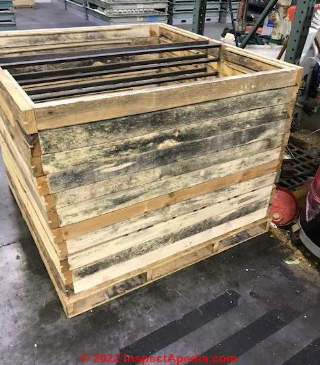
On 2021-09-28 by inspectapedia.com.moderator (mod)
@Christa,
The photo is bit blurry on enlargement, but that looks like a fungus, perhaps a Stemonitis, that tells us that there has been a history of water leaks into the floor. You should follow the water, remove rotted material, fix any leaks, and be alert for discovery of more-extensive moldy material that will need to be cleaned or removed.
On 2021-09-28 by Christa
This is on kitchen floor in a rehab house we are doing. Can u identify it?
On 2021-09-21 by inspectapedia.com.moderator (mod) - Stemonitis often found growing in wet wood, including in bathrooms
@Jess,
Yep; looks like a species of Stemonitis that we often find growing in wet wood, including in bathrooms;
The reason it keeps returning is that when you clean the surface you're leaving the fungal mycelia or "roots" in the wood and wall or floor or window or door and also probably leaving the leak that is giving the necessary moisture:
in other words, you've got a leak into the structure and you should expect to find soft, rotted wood and possibly other mold hidden in the building wall, ceiling, or floor cavity.
On 2021-09-21 by Jess
@Jess, here's another pic from the top down
Hi!we have this mold/fungus that grows up out of the wood in our bathroom about a quarter inch every few months... any thoughts? Northeast Ohio area. It pops up pretty much overnight
On 2021-08-02 by inspectapedia.com.moderator (mod) - no reason to hold up an entire remediation job for a pair of moldy shoes
@Hannah,
Certainly there's no reason to hold up an entire remediation job for a pair of shoes. You may be able to clean them, depending on their condition, but in any event you can remove them immediately, and put them in a sealed plastic container so that work in the building can go ahead.
Or throw the shoes away.
On 2021-08-01 by Hannah
Hi! We are having mold in our basement remediated (it’s aspergillis and cladosporium). We were able to get the cost down by disposing of most of the contents of our basement that can’t easily be wiped down (there’s not much down there).
But my husband has 2 pairs of leather shoes down there and we are wondering if it’s possible for us to clean them? If so, how! It’s the only thing holding this process up these darn shoes!
On 2017-05-27 by (mod)
Our email is at the page top or bottom CONTACT link.
I hope you'll read the thermal tracking articles as that will help you recognize the possible stain patterns and causes that you've mentioned.
On 2017-05-26 by sethrobyn1
Not sure from the pictures on your site....is there a way for me to send a picture? And would bleach remove thermal tracking? Why would they just start to appear? Thanks!
On 2017-05-24 by (mod) What is causing my exterior plaster walls inside my cupboards to turn dark in patches as if it is stained?
Seth
I can't guess from just your e-text, but it's possible that what you're seeing is not mold but thermal tracking stains. Use the search box just above to find our articles on THERMAL TRACKING to check out the stain locations and patterns in your home, then let me know what you think.
On 2017-05-24 by sethrobyn1
What is causing my exterior plaster walls inside my cupboards to turn dark in patches as if it is stained? It just started six months ago and the first time it happened, I cleaned it with bleach and they disappeared.
Now they are back again. Our house is approximately 90 years old. What is causing it? Regular cleaning doesn't work...only with bleach. My kitchen is very humid and we have a dehumidifier going most of the time. I can supply a picture.
On 2017-03-23 by (mod) possible illness related to wet ductwork
Yva
If your doctor agrees, your description is enough to raise a question of building related illness, (as it sounds to me as an amateur), still it'd be odd that you'd import so much dust or chemical from your prior home into the current one to fully explain the symptoms.
From a quick read I see that Sarcoidosis is itself a disease of unknown origin.
Clothing, linens, etc. that have been laundered or dry-cleaned wouldn't be likely to continue to be a significant source of imported contaminants, but other soft-goods such as upholstered furniture or rugs that weren't cleaned / HEPA vaccumed can sometimes import reaction-able levels of mold, allergens, or other contaminants.
Hard-surfaced goods can certainly be simply cleaned with a household cleaner.
It might make sense to have someone competent inspect your present home for obvious hazards including the basics. Then to study the dust or residues you describe you'd need both a pesticide chemical test and particle identification of in both cases representative samples of - a surface swab or pesticide-suspect-contaminated material and of representative settled dust or a vacuum-cassette sample of soft goods surfaces
Use the search box just above to search InspectApedia for DUST SAMPLE METHOD to see an easy way to collect surface dust,
then
Search for VACUUM CASSETTE FILTER SAMPLE TESTS for DUST / MOLD to read how some professionals might sample upholstered goods or a carpet.
The chemical test lab that you or your consultant would select will have advice about what pesticide testing might be most useful and how such samples should be obtained.
If you search InspectApedia for a 3rd article WHEN TO HIRE AN EXPERT there's help deciding if/when such an expense seems justified.
Steer clear of "experts" who for a high fee (or not) stop by to collect a few samples to toss over the wall to a lab who will toss over their wall a report to you - that's not of much use.
On 2017-03-23 by Yva
I recently moved from a place that has quite a bit of water damage but I'm not certain if that is the root of my problem.
While living there, my room was connected via the closet to a grow tent in the garage where pot was being grown. There was a large duct that ran through my closet up and out through the attic.
This duct was often ripped and at one point there was a bug bomb set off for spider mites, there was also powder mold on the plants in addition to other mold in the walls and carpet as well as dust and dust mites and many animals in the home. I have so many allergies and now that I've moved all of my belongings taken from that room trigger my allergies with a burning sensation on my skin, in my lungs, mouth and throat.
I don't know if the culprit is mold, bug spray, dust or what. Is there any way for the lab to tell me what kind of offensive residue is on my belongings.
Some of it feels greasy, other residue feels dusty and powdery. It all burns and itches horribly. Please help. I've pretty much lost all that I own and I am disabled with many medical conditions including Sarcoidosis. I think that I now have CIRS from living in the aforementioned conditions.
On 2017-03-23 by (mod)
Re-posting
@Anna,
Hi Anna, I read a your original post discussing your mold issue. That is an unfortunate situation to be in. You made mention of insulation and attempting to seal from the exterior and adding caulk to seems to eliminate air flow. Although this is a step in the right direction, I don't think it will completely solve your mold problems.
The reason is more to do with air pressure when your HVAC system is running. No matter the level of crevice sealing you do, the air intake will pull moldy, stale air from your unfinished basement/crawl space into the duct work, and release the contaminated air into your home. The only real solution is to stop the water and moisture issue at its source.
I know you aren't in a great position to encapsulate or waterproof your entire home, but I think you could benefit from viewing the material on our website. We have information that discusses mold remediation and waterproofing and insulation. We don't offer services in your location, but I certainly recommend contacting a local encapsulation specialist for a consultation.
They may can at the very least offer you an idea of what will be required to solve your mold issue. In the meantime, please view [ online articles about mold remediation ] to learn more about waterproofing. I will say that in addition to solving your mold issues, encapsulation can help reduce your annual utility bills, which can help offset some of the costs you may initially incur to solve the problem.
Good Luck,
Jason Mullins, Crawl Space & Basement Technologies
Raleigh, NC
On 2017-03-14 by (mod) 8 out of 23 kids in my sons university dorm have been sick
Jackie some mold exposure standards are at MOLD STANDARDS https://inspectapedia.com/mold/Mold-Exposure-Standards.php (found by searching InspectApedia.com for "mold exposure standards" using the search box just above)
Keep in mind that mold spore toxicity varies significantly by size, species, genera, even what the mold is growing upon, and that individual vulnerability also varies widely.
Also, unless there is a specific reason to suspect that mold related illness is at work - such as visible mold, mold odors, or building leak history - it could be a serious error to jump to the assumption that mold is the primary target of a building health and safety investigation.
An on site industrial hygienist familiar with the issues should be involved, or a similar expert, as should the doctors who can express a view of possible causes.
Justa as an example, mis-application of a chemical spray, pesticide, or something else could be at work.
On 2017-03-14 by Jackie
My 8 out of 23 kids in my sons university dorm have been sick with weight loss, skins rashes, and hair loss. The university did a mold test but I have no idea how to tell if the levels are high or potentially causing these illnesses. Do you have a suggestion for having the test interpreted?
On 2017-03-05 by (mod)
Thank you SmithD. We work hard to provide researched and unbaised useful information so as editor I'm really happy when readers find it so. We also welcome questions, content suggestions, critique, content contributions - working together makes us smarter.
Daniel
On 2017-03-05 by Smithb116
Some really quality content on this website , saved to fav. kegbgfeacdedgkag
On 2017-03-05 by Smithd969
I appreciate, cause I found just what I was looking for. You have ended my 4 day long hunt! God Bless you man. Have a great day. Bye cggkggaafccceeaa
On 2017-01-19 by Anna
Hi,
I have appreciated your advice before and I am hoping you can help me out again!
We have a house built in 1958 that is made of brick. It had a long history of water problems in the unfinished block basement, and after we moved in we discovered mold in the attic. We have since ventilated the attic at the soffits and ridge and dried up the basement with gutters, grading, and exterior waterproofing and a curtain drain on the wettest side. We have a very large humidifier keeping our basement below 50% humidity currently.
We have extensive brown and black mold covering the ceiling of our attached garage. The garage has standing water after rain. We plan to fix drainage on the garage side in the spring and rebuild the cracked and bowing wall that is allowing the water in. At that time we will take down the drywall in the garage and replace it with something more mold resistant.
This winter we discovered that we have mold growing inside our living space. We have found spots of brownish mold behind the kitchen backsplash, behind the bulkhead above our cabinets, behind our baseboards, and inside our closets. We think the mold may be due to the high humidity for so many years in the basement, but other theories are possible too:
The exterior of our house is solid masonry. Furring strips are nailed to the masonry and foil paper is either behind or on top of the furring strips (we can't figure out which) with drywall as the final layer. Besides the foil paper, the house is completely uninsulated.
We live in Vermont and routinely experience subzero temperatures. We wonder if the mold, particularly the baseboard mold, could be caused by condensation between our very cold walls and the warm and humid house. All of the mold that we have found in the house, with the exception of a very small amount in a closet, has been located on an exterior wall.
We have started caulking every gap in our exterior wall drywall and trim to reduce air bypass leaks.
We can't afford to replace cabinets, trim, or drywall so we are hoping that a combination of caulking and drying up the basement will be enough to solve our problem, and the mold will be contained enough not to be a health concern. Do you think this is a reasonable expectation?
Also, we can't insulate our house right now due to cost, but we do want to sometime in the future.
We have heard conflicting reports about the best way to insulate brick houses. From what we have read, insulating from the exterior is the most thorough solution, but also the most expensive when you consider the cost of siding and extending the roof overhang to accommodate the increased wall thickness.
A contractor suggested just layering foam board over the existing drywall, but we feel this could invite mold growth in the drywall material caught between the insulation and the block.
Another option we have researched is tearing out the drywall, foil paper and furring strips and applying spray foam directly to the masonry from the interior. What is your suggestion?
Thank you for all of your help. We have used your advice to address our attic and basement problems and hope you can help us here as well.
Anna
Question: Watch out for scare-tactic mold abatement contractors
Watch out ,watch out, watch out ! Watch out for scare tactic doomsday mold abatement contractors. and i use contractors loosely.
Sold a custom spec house to a very unhappy in general lady doc who rented 1st floor of 3 out and tenant soaked floor and surounding area from shower.
After 3 years of blaming me for everything wrong with her home and life i stupidly agreed to help her. big mistake
. i cut out about 10 sq ft of d wall after removing alittle base and floor.
got a mold test from one of these mold mongers and all three floors were off the chart. needless to say all my fault. they recommended 12k of abatement work. no guaranty ,could need more.
yaa $$$ i sprayed the area in bath w/ 50/50 bleach h20 daily for 3 weeks. re tested w/ a different co. and guess what, that's right a miracle ..... no mold ..... 4 bucks o bleach B- WARE - Greg G 5/27/2012
Reply:
Greg G
I agree that the skill level of mold contractors and investigators varies widely.
One step that can protect you is to never use as a mold investigator someone who has any business or financial or other relationship with the mold cleanup company who would do the work if a mold problem is found. For example I have come across a mold remediation company whose principal owner is the mold investigator, a handsome fellow who uses a temperature sensor to find oool spots on the walls claiming it's a "mold detector".
Like any good falsehood, there is a slight possible element of truth, but basically he's not much different than those window salesmen who used to run around with a light meter telling homeowners it was an energy loss meter. True, but false.
Also, anyone who is relying on "bleach" as a mold cure is telling you in advance they don't know what they're doing.
Question: foul odor from a storage room
I have a foul oder coming from a storage room that has no outside ventilation or windows.
This roon has no plumbing nearby and has clean smelling air to the top attic area and below and to the right wall and entry area. T
he only walls i am unable to check is the two outside walls. There is a smell that smells like sewer smell and have no idea what to look for next. - Bill 10/1/12
Reply:
Bill,
Check for a dead animal in a building cavity. Check contests for something that leaked.
See ODORS GASES SMELLS, DIAGNOSIS & CURE our odor diagnosis procedures for details about how to track an odor to it's source & then remove it.
Question: where should outdoor air samples be taken?
Should an outside air sample be taken at the ground level or on the porch which is five feet off the round? - Dan Tewell 9/26/2012
Reply:
Dan,
I would never collect an outdoor airborne mold sample right at ground level unless the purpose is fungal research - that is, an effort to collect fungal spores that are at or on ground level materials.
Few people spend much time inhaling air with their nose on the ground. There are other defects in outdoor air mold level comparisons, as we discuss in mold test validity articles here.
As for taking an air sample on an outdoor porch, that may give a more representative sample, and depending on wind direction and other weather conditions, might avoid severe sampling errors that can occur when using a typical portable slit impaction air sampler or vacuum cassette outdoors in wind.
Older Mold & Sick House FAQS
2017/12/04: Comments placed originally at sickhouse.htm retrieved using @Old-htm-Comments-Retriever.htm
On 2012-02-14 by (mod) - Since mildew grows only on living plants, what you smell is most likely another genus of mold.
Bonsai,
Since mildew grows only on living plants, what you smell is most likely another genus of mold. Often when a building fire is extinguished a considerable volume of water is poured into the building, entering ceilings, walls, floors even of areas where no fire was present. Unless absolutely all of those areas were opened, dried, cleaned, and inspected, there is a high risk of a hidden, possibly significant mold contamination problem.
Indeed it is the responsibility of the building owner to investigate and remedy such problems. And the cost to a tenant who undertook such work alone might be both significant and unfortunately un-welcomed by his landlord. Because a proper investigation of the situation you describe could, on initial investigation by an expert, require invasive test cuts into walls and cavities of the building, and because you're a tenant not an owner, you may not have the owner's permission to permit such steps.
On the other hand, if the building is significantly contaminated by mold, it may not be safely habitable and thus it may not meet the terms of your lease - a question to discuss with your attorney.
At RENTERS & TENANTS GUIDE TO MOLD (use the on page search box to find this article) we give more detailed advice about how you may proceed.
On 2011-11-16 by Bonsai
My issues fall into various categories, so I hope that I am in the right place.
Two months ago, we rented a 19 year old condo in NJ and we’re noticing things that have us worried about our well-being and the habitability of this home.
Earlier this week, we noticed a mildew smell coming from the heating/ac vents in our master bedroom. It can be smelled without the system running if you are close to the vent.
Through research, we found out that there was a fire in this home almost a year ago. The family that was living in the home was displaced for nearly 3 months. Some areas of the floors (on all levels) sag and dip, and there are obvious weak spots when you walk on it.
Several areas of the ceilings appear to have been repaired. Some discoloration (yellow) that is appearing on freshly painted ceilings in the master bedroom and bathroom.
We were, obviously, not told of the fire by the landlord. Since living here, I have been having an exacerbation of my asthma symptoms which is normally very well controlled. We are not sure how to proceed. We are considering having a professional mold inspection of this home done to see if our suspicions are warranted. Should the findings show a serious mold issue, we would then present the findings to our landlord.
I have been researching mold inspection/testing companies, but I am running into a dead end.
The companies that I have contacted do not handle mold inspections or they want to deal with the homeowner directly.
I am looking for information about how to choose an inspector who knows what he is doing and who will not rip us off. I am not worried about the cost of the inspection, but a ball park price of what it would cost would be nice to know so that I do not get scammed.
I am wondering if anyone has any thoughts, recommendations, or other advice for me.
On 2011-10-16 by (mod) -
Kate
Relying on a "mold test" without a competent inspection to find the location of problem mold and to identify what needs to be done to prevent its recurrence is risking wasting money and having to repeat the job.
I agree that if carpeting was wet and suspect it is best to replace it.
If you do not open the wall cavity in a basement that has been flooded you risk leaving a costly problem in place.
These are reasons for having a competent ethical professional, one with no connection to the cleanup work, inspect and advise.
On 2011-10-15 by Kate
We are selling a townhouse and the buyer requested a mold test because of dampness around a basement bedroom window.
Tests results show algae (33), chaetomium (67), Penicillium/Aspergilius (22,133), Pithomyces (67), Rusts (33) and Stachybotrys (33).
The remediation company gave us a proposal to rip all dry wall in the basement (400 sq feet), paint the concrete wall, and clean surfaces. There is paneling over the drywall so we do not yet know the extent of the damage. The wall the window is on is about 10 feet long and 8 feet high.
In readng about the different molds reported, sounds to me that the practical approach is to pull the carpet and pads for replacement, remove paneling starting at the window until we get to the point where there is no mold or water damage, pull that drywall and clean, replace drywall.
It seems pulling all the paneling and drywall in the basement if it has not been exposed to water is overkill, and then not taking the carpet out is a huge mistake and air counts will remain high.
On 2011-10-12 by StevieLee
Thank you so much for your help, I've sent a follow up email to the address on the contacts page.
On 2011-10-12 by (mod) -
Stevie:
Take a look at Readers should see WHEN TO HIRE A MOLD EXPERT for details about how to decide when hiring a mold expert is justified and appropriate.
See MOLD INSPECTORS & MOLD TESTERS for a list of mold investigators whose work is familiar to us. Other mold investigators and test consultants may also be competent and qualified.
There you will find advice on deciding if the case warrants bringing in someone who actually knows how to inspect and test for mold. The procedure you describe sounds unreasonable, inappropriate, over-priced, and unreliable.
If you want to proceed with having detailed comments about your mold report as well as some Q&A that would be necessary for me to advise you with confidence, you can use the CONTACT link found at page top, left, or bottom to proceed.
On 2011-10-12 by StevieLee
Hello,
I'm in a bind over a house we've found that both my wife and I love. The person who is selling it is terrified of mold and convinced the house is making them sick. When we toured the house I could see no sign of mold anywhere nor smell any, and I looked everywhere.
They did a mold test and gave us a copy of the results. However, the company they used also provieds remediation and was quite happy to offer to rip out all the walls looking for mold for $5000. Problem is I cant make head or tail of the report. In problem reports I've seen, the spore counts have been in the thousands or tens of thousands
. Can you help me detrmine if these resultd warrant that kind of remediation or whether it's normal background mold?
Spore trap 1. Living room. Sample Volume 30L. Ascospores, raw ct 3, spr/m3 100, % ttl 9. basidiospores, raw ct 29, sor/m3 667, % ttl 61. Ciadosporium, raw ct 1, spr/m3 33, % ttl 3. Hypal elements, raw ct 1, spr/m3 33, % ttl 3. penicillum/aspergillus group, raw ct 3, spr/m3 100, % ttl 9. smuts, periconia myxomyceates, raw ct 5, spr/m3 157, %ttl 15. Total, raw ct 30, spr/m3 1100. Debris rating 3.
Spore trap 2. Master Bedroom. Sample volume 30L. Ascospores, raw ct 7, spr/m3 233, %ttl 12. Basidiospores, raw ct 16, spr/m3 533, % ttl 27. Ciadosporium, raw ct 17, spr/m3 567, %ttl 29. Hyphal elements, raw ct 4, spr/m3 133, % ttl 7. Pennicilum/aspergillus group, raw ct 3, spr/m3 100, % ttl 5. Pyricularia, raw ct 1, spr/m3 33, % ttl 2. smuts, periconia, myxomycetes, raw ct 11, spr/m3 367, %ttl 19. Total, raw ct 59, spr/m3 1966. Debris rating 3.
Sample 3. Wall beside front door (didn't say inside or out). Wipe, direct microscopic exam. Few aspergillus condiophores seen, 5 per cover slip. Moderate hypal elements seen, 1 to 5 er field. Occasional Insect parts seen, 1 to 5 per cover slip. Few penicillum/aspergillus group spores seen, 5 per cover slip. Occasional stachybortys condiophores seen 1 to 5 per cover slip. Numerous stachybotrys spores seen 3 to 4 per field minimum. Debris rating 3.
On 2011-08-24 by (mod) -
MTB:
Caveat emptor. If you buy now and later find a costly mold cleanup, it'll be all your expense for not having checked thoroughly first.
See MOLD EXPERT, WHEN TO HIRE (article link(links found at the ARTICLE INDEX near the end of this page) ) for help in deciding how far to go in investigating mold at a particular home.
"Black mold" is not the only mold to worry about. Any large mold reservoir indoors (except cosmetic mold) needs to be found, removed, and its cause cured.
Just about every home, even in dry climates, will have a little mold that an experienced investigator can find.
If there is a mold problem in a building that merits professional cleaning (mold remediation), properly conducted that problem is eliminated.
If, then, there is mold in the building in the future, it's from a new leak and a new problem. That's why a key part of mold remediation is finding and fixing the cause.
Also see MOLD RESISTANT CONSTRUCTION
On 2011-08-24 by MTB
Hi, we are considering buying a house in Florida. During a previous inspection they discovered the house had some black mold (the ac area).
The owner hires a remediation company that cleaned the acs and changed some pieces of sheetrock in the ac closet and next to a window. If we were to go ahead and buy the house we would of course hire an inspector to check the house for any remaining mold.
But, I am still worry. Can the black mold really be eliminated? Will the house always have some black mold? What if it is hidden somewhere?
What if something is missed during the cleaning and a couple of years down the road we have a mold problem? I really appreciate your opinion. I find a lot of scary stories about black mold in the internet, and the first instinct is to stay away from the house. But is that an over-reaction? Thanks
On 2011-07-28 by (mod) -
Mamamamama
The small total square inches of mold that one would typically find in a bathroom shower along the wall/shower top junction is unlikely to be itself a health risk in a building and should be addressed by normal bathroom cleaning.
IF there is evidence that water has leaked into the building walls, ceilings, or floors then that condition is worth evaluating further.
On 2011-07-28 by Mamamea33
We have been renting a townhouse for five years. We recently discovered mold in our shower, along the top where the fiberglass meets the wall. The mold in the corners was several inches high. Our landlord wiped it down with bleach and called it a day. He said mold does not cause health problems and the only toxic mold is in other countries (we live in California).
About a year ago we had a leak from the upstairs shower (where the mold is); the water drained into our laundry room through a light fixture in the ceiling. The landlord fixed the leak but did not replace the wet sheetrock around the fixture, or dry out the area between the floor and ceiling with fans.
We have a 6-month-old baby and a preschool-age child. I am worried that the mold in the shower means there is mold behind the walls, and our landlord does not think it is a problem so he won't hire someone to check it out.
We are debating moving just out of sheer frustration (not knowing if there is a problem or not), but we enjoy our home and it is a great price for the area.
It will cost us a lot of money to move. But we want to keep our kids safe. I don't want to make a big fuss, but I do want to know if moving is the right thing, or if we can check whether mold is a serious issue here without damaging the property.
Thank you!
(Dec 23, 2012) Tewaffose said:
Another case write up was documented in Australian troops treated with doxycycline 100 mg always to malaria prophylaxis while on deployment in East Timor, a accumulation of islands within the Malaysian archipelago located close to the equator
. Of the 135 troops, 22 exhibited phototoxic reactions to low dosages of doxycycline that resembled primitive sunburn with erythematous plaques on the sun-exposed areas. The troops against a sunscreen containing oxybenzone.
(Oct 10, 2012) Appliances repair OC said:
Hola inspectapedia.com . Encontré su sitio web a través de Google en la búsqueda de una cuestión similar, su sitio web tiene aquí arriba.
Parece bueno. Tengo marcado en mis favoritos de Google para volver más tarde. saludos!
(Sept 4, 2012) escorts Paris said:
En realidad, la intención de discutir su entrada en el blog es increíblemente realista. Yo la opción de escuchar algo totalmente nuevo con esto a causa de que realmente proporciona el mismo sitio dentro de mi Estados Unidos durante esta materia por lo que esta ayuda específica?
Un montón todos los s. Tuve la oportunidad de una buena mirada sobre el tema, además notó un gran un número de blogs, pero en contraste con eso. Gracias por revelar tanto dentro inspectapedia.com
(Sept 3, 2012) seo website said:
Nada en contra del artículo, pero no estoy de acuerdo con un par de puntos a algunos extenct. Soy probablemente una minoría, sin embargo, lol. Gracias por compartirlo en inspectapedia.com.
...
Continue reading at MOLD CONTAMINATION IN BUILDINGS - topic home, or select a topic from the closely-related articles below, or see the complete ARTICLE INDEX.
Or see MOLD CONTAMINATION in BUILDINGS, FAQs-2 - more-recent questions and answers about mold contamination in buildings.
Or see these
Recommended Articles
- ACCEPTABLE MOLD LEVEL
- MOLD CONTAMINATION IN BUILDINGS - home - CONTENTS: building mold contamination guide: How to Find, Test, Inspect For, Remove, & Prevent Indoor Mold Contamination what to do about harmful indoor mold.
- MOLD DOCTORS - ENVIRONMENTAL MEDICINE
- MOLD / ENVIRONMENTAL EXPERT, HIRE ?
Suggested citation for this web page
MOLD CONTAMINATION in BUILDINGS, FAQs at InspectApedia.com - online encyclopedia of building & environmental inspection, testing, diagnosis, repair, & problem prevention advice.
Or see this
INDEX to RELATED ARTICLES: ARTICLE INDEX to MOLD CONTAMINATION & REMEDIATION
Or use the SEARCH BOX found below to Ask a Question or Search InspectApedia
Ask a Question or Search InspectApedia
Try the search box just below, or if you prefer, post a question or comment in the Comments box below and we will respond promptly.
Search the InspectApedia website
Note: appearance of your Comment below may be delayed: if your comment contains an image, photograph, web link, or text that looks to the software as if it might be a web link, your posting will appear after it has been approved by a moderator. Apologies for the delay.
Only one image can be added per comment but you can post as many comments, and therefore images, as you like.
You will not receive a notification when a response to your question has been posted.
Please bookmark this page to make it easy for you to check back for our response.
Our Comment Box is provided by Countable Web Productions countable.ca
Citations & References
In addition to any citations in the article above, a full list is available on request.
- In addition to citations & references found in this article, see the research citations given at the end of the related articles found at our suggested
CONTINUE READING or RECOMMENDED ARTICLES.
- Carson, Dunlop & Associates Ltd., 120 Carlton Street Suite 407, Toronto ON M5A 4K2. Tel: (416) 964-9415 1-800-268-7070 Email: info@carsondunlop.com. Alan Carson is a past president of ASHI, the American Society of Home Inspectors.
Thanks to Alan Carson and Bob Dunlop, for permission for InspectAPedia to use text excerpts from The HOME REFERENCE BOOK - the Encyclopedia of Homes and to use illustrations from The ILLUSTRATED HOME .
Carson Dunlop Associates provides extensive home inspection education and report writing material. In gratitude we provide links to tsome Carson Dunlop Associates products and services.


